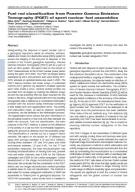Details
- Identification
- ISSN: 1977-5296, DOI: 10.3011/ESARDA.IJNSNP.2020.8
- Publication date
- 1 December 2020
- Author
- Joint Research Centre
Description
Volume: 61, December 2020, pages 10-21,
Authors: Riina Virta1,2, Rasmus Backholm3, Tatiana A. Bubba3, Tapio Helin4, Mikael Moring2, Samuli Siltanen3, Peter Dendooven1, Tapani Honkamaa2
1Helsinki Institute of Physics - University of Helsinki, 2Radiation and Nuclear Safety Authority (STUK), 3Department of Mathematics and Statistics - University of Helsinki, 4School of Engineering Science - LUT University
Abstract:
Safeguarding the disposal of spent nuclear fuel in a geological repository needs an effective, efficient, reliable and robust non-destructive assay (NDA) system to ensure the integrity of the fuel prior to disposal. In the context of the Finnish geological repository, Passive Gamma Emission Tomography (PGET) will be a part of such an NDA system. We report here on the results of PGET measurements at the Finnish nuclear power plants during the years 2017-2020. The PGET prototype device developed by IAEA and partners was used during 2017- 2019, whereas an updated device was used in 2020. The PGET device contains two linear arrays of collimated CdZnTe (CZT) gamma ray detectors installed opposite each other inside a torus. Gamma activity profiles are recorded from all angles by rotating the detector arrays around the fuel assembly that has been inserted into the center of the torus. Image reconstruction from the resulting tomographic data is defined as a constrained minimization problem with the function being minimized containing a data fidelity term and regularization terms. The activity and attenuation maps, as well as detector sensitivity corrections, are the variables in the minimization process. The regularization terms ensure that prior information on the (possible) locations of fuel rods and their diameter are taken into account. Fuel rod classification, the main purpose of the PGET method, is based on the difference of the activity of a fuel rod from its immediate neighbors, taking into account its distance from the assembly center. The classification is carried out by a support vector machine. We report on the results for 10 different fuel types with burnups between 5.72 and 55.0 GWd/tU, cooling times between 1.87 and 34.6 years and initial enrichments between 1.9 and 4.4%. For the 77 fuel assemblies measured, the total misclassification rate including misclassifications of missing fuel rods, present rods and water channels, was 0.94% for the Olkiluoto campaigns and 0.66% for the Loviisa campaigns. Further development of the image reconstruction method is discussed. We conclude that the combination of the PGET device and our image reconstruction method provides a reliable base for fuel rod classification. The method is well-suited for nuclear safeguards verification of BWR fuel assemblies in Finland prior to geological disposal. For VVER-440 assemblies, some further work is needed to investigate the ability to detect missing rods near the center of the assembly.
Keywords: geological repository; iterative reconstruction; nuclear fuel; nuclear safeguards; PGET
Reference guideline:
Virta, R., Backholm, R., Bubba, T.A., Helin, T., Moring, M., Siltanen, S., Dendooven, P., & Honkamaa, T. (2020). Fuel rod classification from Passive Gamma Emission Tomography (PGET) of spent nuclear fuel assemblies. ESARDA Bulletin - The International Journal of Nuclear Safeguards and Non-proliferation, 61, 10-21. https://doi.org/10.3011/ESARDA.IJNSNP.2020.8

